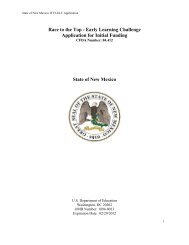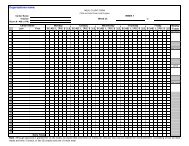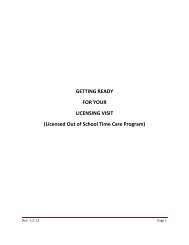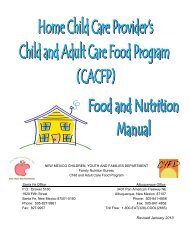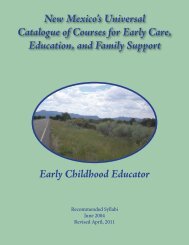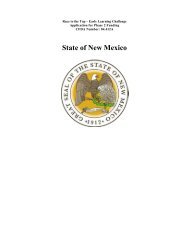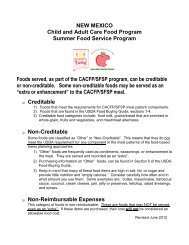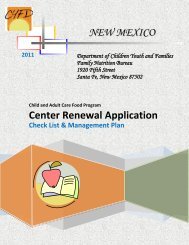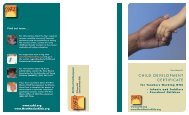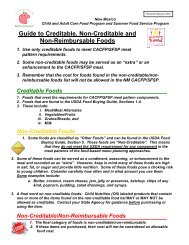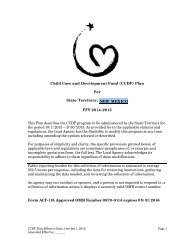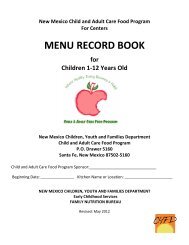Nutrition and Wellness Tips for Young Children - New Mexico Kids
Nutrition and Wellness Tips for Young Children - New Mexico Kids
Nutrition and Wellness Tips for Young Children - New Mexico Kids
Create successful ePaper yourself
Turn your PDF publications into a flip-book with our unique Google optimized e-Paper software.
How To Use This H<strong>and</strong>bookSymbols Used in the Tip SheetsMany of the nutrition tip sheets include a section on making sure foods are safe to eat. A cautionsymbol points out foods that may cause an allergic reaction or pose a choking hazard. A creditingsymbol calls attention to in<strong>for</strong>mation about crediting foods within the Child <strong>and</strong> Adult Care FoodProgram (CACFP) meal.ALLERGY!This symbol means the food may cause an allergic reaction in some children.CHOKING!✓This symbol means the food may cause children under 4 years old to choke.This symbol appears next to tips <strong>for</strong> crediting foods within CACFP meals <strong>and</strong> snacks.Supplemental SectionSupplement A includes in<strong>for</strong>mation about choking hazards <strong>for</strong> children under the age of 4 years.Child care providers can use these tips to reduce the risk of choking in their day care homes <strong>and</strong>centers.Supplement B includes in<strong>for</strong>mation about common food allergies, as well as in<strong>for</strong>mation on whatchild care providers should do if a child in their care has a food allergy.Best Practices: CACFP Success StoriesThis section shares the best practices <strong>and</strong> successful tips of nine CACFP child care programsfrom across the United States. They include stories from various parts of the country <strong>and</strong> diversecommunities. These child care programs have tried new <strong>and</strong> exciting ways to improve the foodthat they serve children <strong>and</strong> the activities that they plan. Each story is unique, yet practical <strong>and</strong>applicable <strong>for</strong> many providers. Together, these stories provide inspiration <strong>for</strong> anyone who wants tocreate healthy environments <strong>for</strong> children <strong>and</strong> child care programs everywhere.Additional ResourcesThis section includes additional resources on active play, child care policies <strong>and</strong> practices,nutrition, food safety, choking hazards, food allergies, <strong>and</strong> screen time. These resources includetool kits, checklists, child care self-assessment tools, wellness policy resources, ideas <strong>for</strong> childcare activities, nutrition education materials, gardening education resources, nutrition programin<strong>for</strong>mation, food safety materials, <strong>and</strong> reports on national guidelines <strong>and</strong> recommendationspertaining to wellness in child care.4<strong>Nutrition</strong> <strong>and</strong> <strong>Wellness</strong> <strong>Tips</strong> <strong>for</strong> <strong>Young</strong> <strong>Children</strong>: Provider H<strong>and</strong>book <strong>for</strong> the Child <strong>and</strong> Adult Care Food ProgramHow To Use This H<strong>and</strong>book • http://www.teamnutrition.usda.gov/library.html



